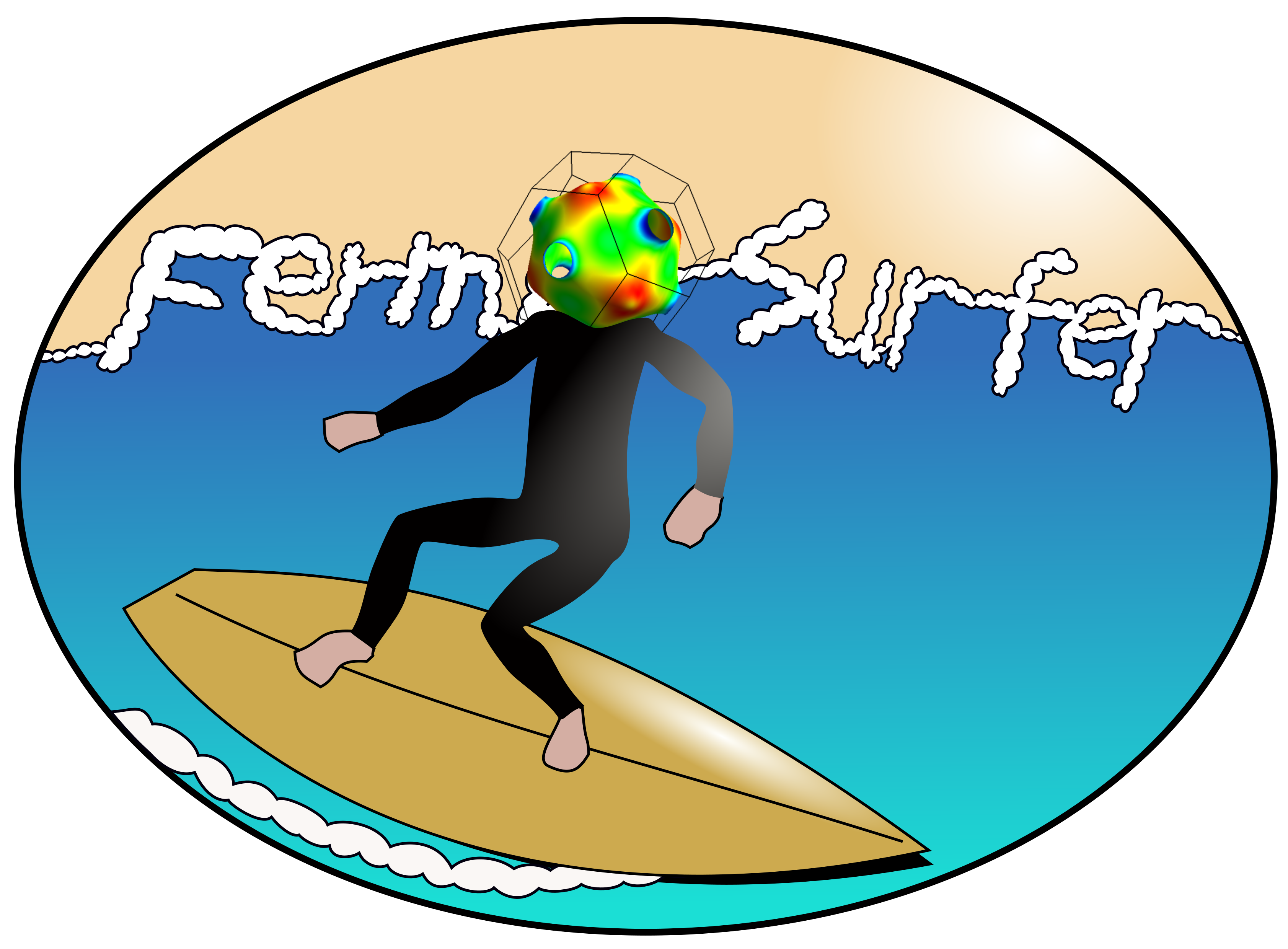Input file¶
input-file format¶
You have to prepare following data:
The number of \(k\) grid (three direction)
Reciprocal lattice vectors
The number of bands
The orbital energy at each band and \(k\) (We call it “energy”) .
Variables that you want to plot with color (We call it “matrix elements”).
The input file is as follows (mgb2_vfz.fs):
40 40 36 (1)
0 (2)
3 (3)
1.0000000 0.57735026 -0.0000000 (4)
0.0000000 1.1547005 0.0000000 (5)
0.0000000 -0.0000000 0.87206507 (6)
2.91340202E-02 (7)
2.93242838E-02
2.98905596E-02
3.08193434E-02
:
:
0.14393796
0.12800488
0.0000000 (8)
0.36269817
0.71675694
1.0535113
1.3644149
:
:
-26.409407
-19.318560
-10.315671
The number of \(k\) in each direction
Switch to specify type of \(k\) grid (Choose from
0, 1, 2)\(k\) grid is represented as follows:
\[\begin{align} {\boldsymbol k}_{i,j,k} = x_i {\boldsymbol b}_1 + y_j {\boldsymbol b}_2 + z_k {\boldsymbol b}_3, \end{align}\]where \(i, j, k = 1 \cdots N_1, 1 \cdots N_2, 1 \cdots N_3\) , and \(N_1, N_2, N_3\) are the number of \(k\) in each direction.
\(x_i, y_j,z_k\) can be chosen from below:
0(Monkhorst-Pack grid) : \(x_i = \frac{2 i - 1 - N_1}{2 N_1}\)1: \(x_i = \frac{i - 1}{N_1}\)2: \(x_i = \frac{2 i - 1}{2 N_1}\)
The number of bands
Reciprocal lattice vector 1 (arbitrary unit)
Reciprocal lattice vector 2
Reciprocal lattice vector 3
Energy (The order of component is written in How to produce the input file in C and fortran programs )
fermisurferassume that the Fermi energy is0.0in the default. You can shift the Fermi energy by usingShift Fermi Energymenu described at the section 6.5.Matrix elements (The order of component is written in How to produce the input file in C and fortran programs )
Same as the energy, but in this case we can write 0 to 3 blocks for this quantity, i.e. we can omit to write this.
BXSF format¶
The BXSF format also can be treated by FermiSurfer. In this case this program behaves as “Matrix elements” are omitted.
How to produce the input file in C and fortran programs¶
fortran
real(4) :: bvec1(3), bvec2(3), bvec3(3) ! Resiplocal lattice vector
integer :: nk1, nk2, nk3 ! k-grid of each direction
integer :: ishift ! 1 for shifted grid, 0 for unshifted grid.
integer :: nbnd ! The number of bands
real(4) :: eig(nk3,nk2,nk1,nbnd) ! energy
real(4) :: x(nk3,nk2,nk1,nbnd) ! matrix element
integer :: ik1, ik2, ik3, ibnd, fo
open(fo, file = "sample.fs")
write(fo,*) nk1, nk2, nk3
write(fo,*) ishift
write(fo,*) nbnd
write(fo,*) real(bvec1(1:3))
write(fo,*) real(bvec2(1:3))
write(fo,*) real(bvec3(1:3))
do ibnd = 1, nbnd
do ik1 = 1, nk1
do ik2 = 1, nk2
do ik3 = 1, nk3
write(fo,*) real(eig(ik3,ik2,ik1,ibnd))
end do
end do
end do
end do
do ibnd = 1, nbnd
do ik1 = 1, nk1
do ik2 = 1, nk2
do ik3 = 1, nk3
write(fo,*) real(x(ik3,ik2,ik1,ibnd))
end do
end do
end do
end do
close(fo)
C
float bvec1[3], bvec2[3], bvec3[3]; /*Resiplocal lattice vector*/
int nk1, nk2, nk3; /*k-grid of each direction*/
int ishift; /*1 for shifted grid, 0 for unshifted grid.*/
int nbnd; /*The number of bands*/
float eig[nbnd][nk1][nk2][nk3]; /*Energy*/
float x[nbnd][nk1][nk2][nk3]; /*Matrix element*/
FILE* fo;
int ibnd, ik1, ik2, ik3;
fo = fopen("sample.frmsf", "w");
ierr = fprintf(fo, "%d %d %d\n", nk1, nk2, nk3);
ierr = fprintf(fo, "%d\n", iswitch);
ierr = fprintf(fo, "%d\n", nbnd);
ierr = fprintf(fo, "%e %e %e\n", bvec1[0], bvec1[1], bvec1[2]);
ierr = fprintf(fo, "%e %e %e\n", bvec2[0], bvec2[1], bvec2[2]);
ierr = fprintf(fo, "%e %e %e\n", bvec3[0], bvec3[1], bvec3[2]);
for (ibnd = 0; ibnd < nbnd; ++ibnd) {
for (ik1 = 0; ik1 < nk1; ++ik1) {
for (ik2 = 0; ik2 < nk2; ++ik2) {
for (ik3 = 0; ik3 < nk3; ++ik3) {
ierr = fprintf(fo, "%e\n", eig[ibnd][ik1][ik2][ik3]);
}
}
}
}
for (ibnd = 0; ibnd < nbnd; ++ibnd) {
for (ik1 = 0; ik1 < nk1; ++ik1) {
for (ik2 = 0; ik2 < nk2; ++ik2) {
for (ik3 = 0; ik3 < nk3; ++ik3) {
ierr = fprintf(fo, "%e\n", x[ibnd][ik1][ik2][ik3]);
}
}
}
}
fclose(fo);
For the 2D color plot (See srvo3_t2g.frmsf in examples)¶
fortran
real(4) :: bvec1(3), bvec2(3), bvec3(3) !Resiplocal lattice vector
INTEGER :: nk1, nk2, nk3 !k-grid of each direction
integer :: ishift !1 for shifted grid, 0 for unshifted grid.
integer :: nbnd !The number of bands
real(4) :: eig(nk3,nk2,nk1,nbnd) !energy
real(4) :: x(nk3,nk2,nk1,nbnd,2) !matrix element (2D or complex)
integer :: ik1, ik2, ik3, ibnd, fo, ii
open(fo, file = "sample.frmsf")
write(fo,*) nk1, nk2, nk3
write(fo,*) ishift
write(fo,*) nbnd
write(fo,*) real(bvec1(1:3))
write(fo,*) real(bvec2(1:3))
write(fo,*) real(bvec3(1:3))
do ibnd = 1, nbnd
do ik1 = 1, nk1
do ik2 = 1, nk2
do ik3 = 1, nk3
write(fo,*) real(eig(ik3,ik2,ik1,ibnd))
end do
end do
end do
end do
do ii = 1, 2
do ibnd = 1, nbnd
do ik1 = 1, nk1
do ik2 = 1, nk2
do ik3 = 1, nk3
write(fo,*) real(x(ik3,ik2,ik1,ibnd,ii))
end do
end do
end do
end do
close(fo)
Omit the quantity for the color plot¶
fortran
real(4) :: bvec1(3), bvec2(3), bvec3(3) ! Resiplocal lattice vector
INTEGER :: nk1, nk2, nk3 ! k-grid of each direction
integer :: ishift ! 1 for shifted grid, 0 for unshifted grid.
integer :: nbnd ! The number of bands
real(4) :: eig(nk3,nk2,nk1,nbnd) ! energy
integer :: ik1, ik2, ik3, ibnd, fo, ii
open(fo, file = "sample.frmsf")
write(fo,*) nk1, nk2, nk3
write(fo,*) ishift
write(fo,*) nbnd
write(fo,*) real(bvec1(1:3))
write(fo,*) real(bvec2(1:3))
write(fo,*) real(bvec3(1:3))
do ibnd = 1, nbnd
do ik1 = 1, nk1
do ik2 = 1, nk2
do ik3 = 1, nk3
write(fo,*) real(eig(ik3,ik2,ik1,ibnd))
end do
end do
end do
end do
